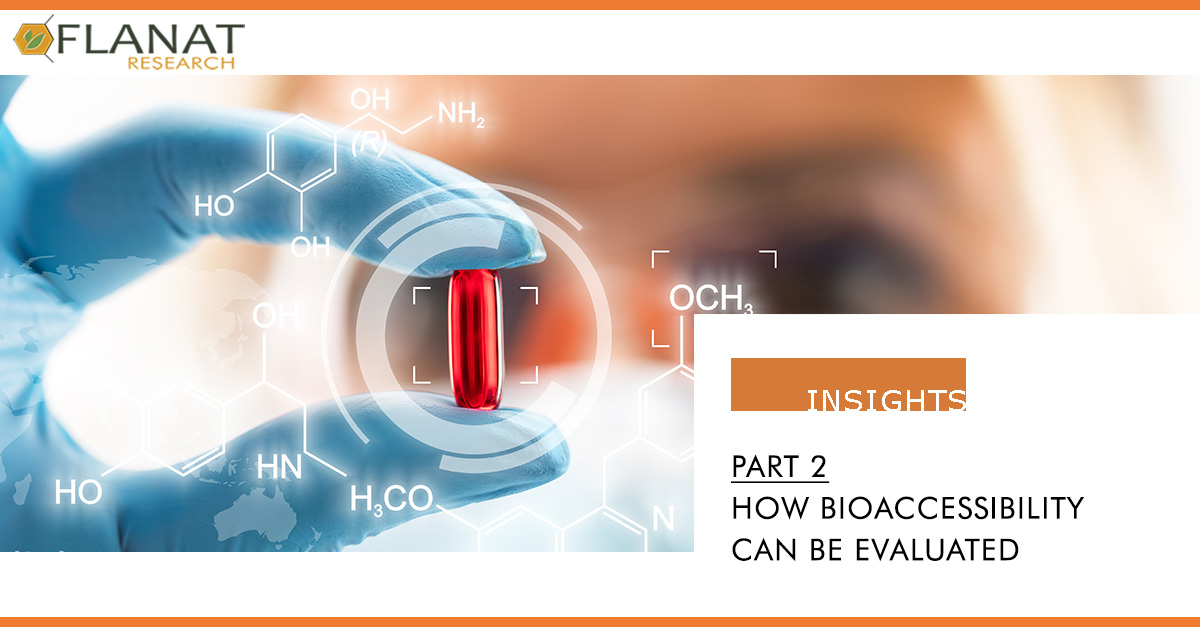In PART 1 we acknowledge that the bioaccessibility of a compound is the amount that is released from its matrix in the gastrointestinal tract, making it available to enter the bloodstream. We will now look at methods for determining the amount of compound available to be absorbed.
It can obviously be affirmed that the optimal method to determine the bioaccessibility of a compound is through the study of animal or human models (in vivo) capable of providing precise data; however, these studies have limited use as they are economically demanding, time consuming, and have ethical limitations. For this reason, knowledge of digestion is essential to simulate an adequate digestive process in the laboratory (in vitro) considering all the variables involved, such as digestive enzymes, the pH in the gastric and intestinal phase, the digestion time and the concentration of salts present in the digestive tract.
Over the years, various simulations models have been designed simulating the physiological conditions and events that occur during digestion in humans, but given the complexity of the human organism, it has not been possible to recreate an in vitro model that uniquely reflects the physiological conditions and events occurring in human during digestion. In vivo studies, both on animal and human models, generally allow more precise results to be obtained and for this reason they are still considered the "gold standard" for this type of study, although little used given the reasons already described above. For this reason, in vitro models are used to predict the in vivo performance of the formulation, so these digestion protocols must be designed to mimic the performance in the organism as much as possible. At the same time, we also want in vitro models to be fast, labor-intensive, robust and economical. So the protocols used are typically a compromise between complexity and practicality.
In vitro methods can be distinguished as static or dynamic models. Static models, also called biochemical models, are the simplest and are used above all for foods and primary formulations such as powders or liquids, to isolate or purify nutrients or to isolate allergenic proteins. Static models involve the incubation of the food or formulation in a series of bioreactors in which the physiological and enzymatic environment of each digestive compartment is mimicked. Dynamic models can be mono- or multicompartmental and allow the incorporation of physical processes and temporal changes in the conditions of the gastrointestinal tract, in order to better mimic in vivo conditions. (Dupont D. et al. 2019)
An advanced multi-organ cellular model, capable of reproducing the gastro-intestinal system, has been developed at the University of Pavia from the research group of Professor Papetti. The dynamic millifluidic model is based on the LiveFlow® bioreactor, (IvTech Srl - Massarosa - LU Italia), a versatile platform for recreating different cellular or tissue models, even in a multi-organ approach. The multicompartmental system associate gastric (GIST-882) and intestinal (Caco-2) cells, causing molecules to continuously flow onto the cells. The gastric and intestinal environment is therefore reproduced in the different compartments in order to determine the gastric and intestinal absorption and the metabolic profile of the sample flowing within the system. (Colombo R. et al. 2019)
In general, all in vitro digestion processes can be divided into several phases (oral, gastric and intestinal) and can be studied separately or in combination with each other based on the aim of the study. Several models have been so developed and all different from each other. The first ones developed, for example, do not contemplate the oral phase due to the complexity to simulate the mastication and the formation of the bolus, some other models have simplified this phase just homogenizing the food. Other more advanced methods have instead added the colon phase to the 3 main phases (oral, gastric and intestinal), in order to comprehensively study the digestion process. (Minekus M. et al. 2014; Hamzalıoğlu A. et al. 2015)
The result obtained with an in vitro digestion can be significantly influenced by many factors: the sample characteristics, the digestive fluids composition, the mechanical stress, the incubation times and above all the enzymatic activity. This last is, in fact, in turn influenced by many factors such as the enzymes concentration, the pH of fluids in which they are found, the incubation temperature, their stability, the presence of activators or inhibitors and the incubation times. In vitro static digestion methods have attracted the interest of many researchers who have understood their potential application in various fields for the purpose of evaluating the bioavailability of different samples.
Although the static digestion may appear to be an easy method, the lack of consensus regarding the physiological conditions to be used has led to the creation of several models, very different to each other’s, which results are impossible to compare.
INFOGEST, an international research network, developed in 2015, thanks to a group of 200 researchers from all over the world, a static in vitro digestion model with the aim of harmonizing existing models. INFOGEST method is still recognized today as the official standard regarding these experiments. This standardization makes it possible to apply the same conditions even in different laboratories, thus obtaining excellent reproducibility of the results.
Part 3 will explain which method are used in our laboratory to evaluate bioaccessibility

